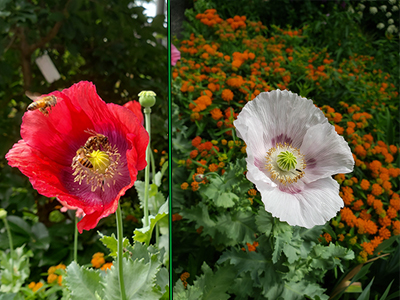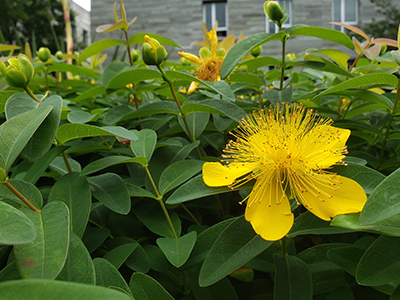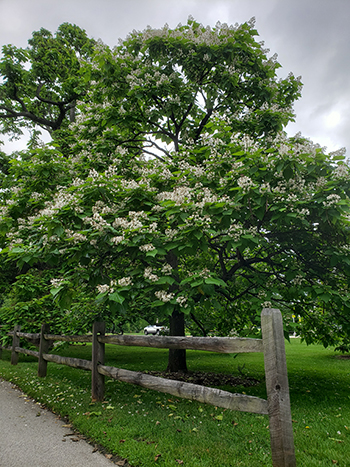
Plants of the Week: June 21
Guest Author: Hailey Dunbar

Papaver somniferum, the opium poppy, is an annual ornamental flower that provides a jaw-dropping blast of color in the landscape. The flowers exhibit their stunning visage in a wide array of colors that include pure white, light lavender, deep scarlet, vibrant orange, or even a mesmerizing dark purple. The beautiful grey-blue hue of the foliage enhances the bold petals, while its upright linear stature ensures it is never overlooked. Inevitably the flowers will fade, but do not fret, for the seed pods it produces are equally splendid.
In addition to its ravishing ornamental value, this plant is also responsible for the production of poppy seeds and opium, the main alkaloid from which morphine is derived. This medicine was dubbed ‘morphine’ after Morpheus, the Greek god of sleep and dreams. You can visit these lovely mixed blooms in the Scott Entrance Garden. Photo credit: H. Dunbar

Hypericum calycinum, or creeping St. John’s wort, is a vibrant yellow-flowering low-growing shrub that is a great groundcover tolerant of both shade and sun. Its lush green foliage complements the showy floral display, and many bees are sure to be seen buzzing by.
While the name ‘wort’ might initially appear distasteful to some, it actually originates from the Old English term ‘wyrt’, simply meaning plant. Historically, many members of the Hypericum genus have been used medicinally to treat asthma, depression, and neurological disorders. Beware of exposure to livestock, as the compound known as hypericin that is derived for human medicinal use can be toxic to horses, cattle, and sheep. Typically it is nonfatal in healthy populations of livestock, and it still makes a wonderful addition to the garden! This specimen can be found in full bloom in Gold Medal Garden. Photo credit: H. Dunbar

Catalpa bignonioides, the southern catalpa, is a large asymmetric tree with broad cordate foliage and a lush array of white flowers. The epithet ‘bignonioides’ is derived from the Latin root -oides, meaning ‘resembling’, as it is reminiscent of a bignonia flower. It is native to many southern states, including Missouri, Alabama, Georgia, and Florida, but can be found in other portions of the United States. This tree is known to become inhabited by Ceratomia catalpae, or catalpa sphinx caterpillars.
In the South, they are called catalpa worms and even catawba worms. These voracious creatures are capable of defoliating an entire tree within a short span during their larval stage in the summer months, but the trees usually recover quite well. Southern catalpa trees are often grown with the sole intent of attracting these caterpillars (which serve as delectable treats to many fish), and are harvested by fisherman interested in casting a line with the juicy bait. Due to the sufficient recovery of the trees after defoliation, the plethora of natural enemies (mainly Cotesia congregata, an endoparasitoid wasp), and the allure of their bait-like quality, these insects are not typically treated or killed. You can see the lovely summer flower display of this southern gem across from Magnolia Collection. Photo credit: H. Dunbar





No Comments